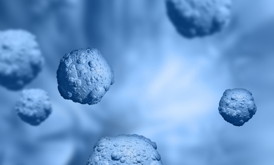Home > Press > A breakthrough in nanotoxicology by INRS researchers: Silver nanoparticles and inflammation
 |
Abstract:
Whereas resistance to antibiotics complicates certain treatments, antimicrobial silver nanoparticles (AgNP) are gaining popularity for medical use. These particles are toxic for certain bacteria, but what about for humans? Researchers at INRS-Institut Armand-Frappier Research Centre have taken a step toward understanding the cellular and molecular mechanisms that affect these particles. In an article published in The Journal of Biological Chemistry, Denis Girard's team established for the first time that AgNP induce stress in the endoplasmic reticulum (ER), which is one of the signs of nanotoxicity.
A breakthrough in nanotoxicology by INRS researchers: Silver nanoparticles and inflammation
Québec, Canada | Posted on February 18th, 2015In their experiment, the researchers used 15 nm AgNP on human monocytes and macrophages, which are among the first cells to interact with foreign bodies. At low concentrations, the AgNP induced stress in the ER, but did not cause cell death. However, higher concentrations did cause a type of programmed cellular death, which is characteristic of certain inflammatory responses.
The research team's results suggest that the AgNP cause degradation of the ER's ATF-6 sensor and activation of the NLRP-3 protein complex. It is the first time that an inflammatory response to AgNP particles in this protein complex has been reported.
Following up on these results, Professor Girard's team will study the ATF-6 molecule more closely in order to better understand the mode of action of various nanoparticles with respect to myeloid cells.
Professor Girard believes these research results using THP-1 cells also open up other research possibilities: "We used leukemia cells throughout most of the study. The question is, could we achieve the same results with other types of cancer cells? If so, it may be possible to use nanoparticles to kill cancer cells without the use of drugs, which would be very promising."
####
About INRS
Institut national de recherche scientifique (INRS) is a graduate-level research and training university and ranks first in Canada for research intensity (average grant funding per faculty member). INRS brings together some 150 professors as well as 700 students and postdoctoral fellows at its four centres in Montreal, Quebec City, Laval, and Varennes. Its applied and fundamental research is essential to the advancement of science in Quebec and internationally even as it plays a key role in the development of concrete solutions to the problems faced by our society.
For more information, please click here
Contacts:
Stéphanie Thibault
514-499-6612
Copyright © INRS
If you have a comment, please Contact us.Issuers of news releases, not 7th Wave, Inc. or Nanotechnology Now, are solely responsible for the accuracy of the content.
| Related Links |
| Related News Press |
News and information
![]() Researchers develop molecular qubits that communicate at telecom frequencies October 3rd, 2025
Researchers develop molecular qubits that communicate at telecom frequencies October 3rd, 2025
![]() Next-generation quantum communication October 3rd, 2025
Next-generation quantum communication October 3rd, 2025
![]() "Nanoreactor" cage uses visible light for catalytic and ultra-selective cross-cycloadditions October 3rd, 2025
"Nanoreactor" cage uses visible light for catalytic and ultra-selective cross-cycloadditions October 3rd, 2025
Nanomedicine
![]() New molecular technology targets tumors and simultaneously silences two ‘undruggable’ cancer genes August 8th, 2025
New molecular technology targets tumors and simultaneously silences two ‘undruggable’ cancer genes August 8th, 2025
![]() New imaging approach transforms study of bacterial biofilms August 8th, 2025
New imaging approach transforms study of bacterial biofilms August 8th, 2025
![]() Cambridge chemists discover simple way to build bigger molecules – one carbon at a time June 6th, 2025
Cambridge chemists discover simple way to build bigger molecules – one carbon at a time June 6th, 2025
![]() Electrifying results shed light on graphene foam as a potential material for lab grown cartilage June 6th, 2025
Electrifying results shed light on graphene foam as a potential material for lab grown cartilage June 6th, 2025
Discoveries
![]() Researchers develop molecular qubits that communicate at telecom frequencies October 3rd, 2025
Researchers develop molecular qubits that communicate at telecom frequencies October 3rd, 2025
![]() Next-generation quantum communication October 3rd, 2025
Next-generation quantum communication October 3rd, 2025
![]() "Nanoreactor" cage uses visible light for catalytic and ultra-selective cross-cycloadditions October 3rd, 2025
"Nanoreactor" cage uses visible light for catalytic and ultra-selective cross-cycloadditions October 3rd, 2025
Announcements
![]() Rice membrane extracts lithium from brines with greater speed, less waste October 3rd, 2025
Rice membrane extracts lithium from brines with greater speed, less waste October 3rd, 2025
![]() Researchers develop molecular qubits that communicate at telecom frequencies October 3rd, 2025
Researchers develop molecular qubits that communicate at telecom frequencies October 3rd, 2025
![]() Next-generation quantum communication October 3rd, 2025
Next-generation quantum communication October 3rd, 2025
![]() "Nanoreactor" cage uses visible light for catalytic and ultra-selective cross-cycloadditions October 3rd, 2025
"Nanoreactor" cage uses visible light for catalytic and ultra-selective cross-cycloadditions October 3rd, 2025
Interviews/Book Reviews/Essays/Reports/Podcasts/Journals/White papers/Posters
![]() Spinel-type sulfide semiconductors to operate the next-generation LEDs and solar cells For solar-cell absorbers and green-LED source October 3rd, 2025
Spinel-type sulfide semiconductors to operate the next-generation LEDs and solar cells For solar-cell absorbers and green-LED source October 3rd, 2025
![]() Rice membrane extracts lithium from brines with greater speed, less waste October 3rd, 2025
Rice membrane extracts lithium from brines with greater speed, less waste October 3rd, 2025
Safety-Nanoparticles/Risk management
![]() Onion-like nanoparticles found in aircraft exhaust May 14th, 2025
Onion-like nanoparticles found in aircraft exhaust May 14th, 2025
![]() Closing the gaps — MXene-coating filters can enhance performance and reusability February 28th, 2025
Closing the gaps — MXene-coating filters can enhance performance and reusability February 28th, 2025
|
|
||
|
|
||
| The latest news from around the world, FREE | ||
|
|
||
|
|
||
| Premium Products | ||
|
|
||
|
Only the news you want to read!
Learn More |
||
|
|
||
|
Full-service, expert consulting
Learn More |
||
|
|
||








